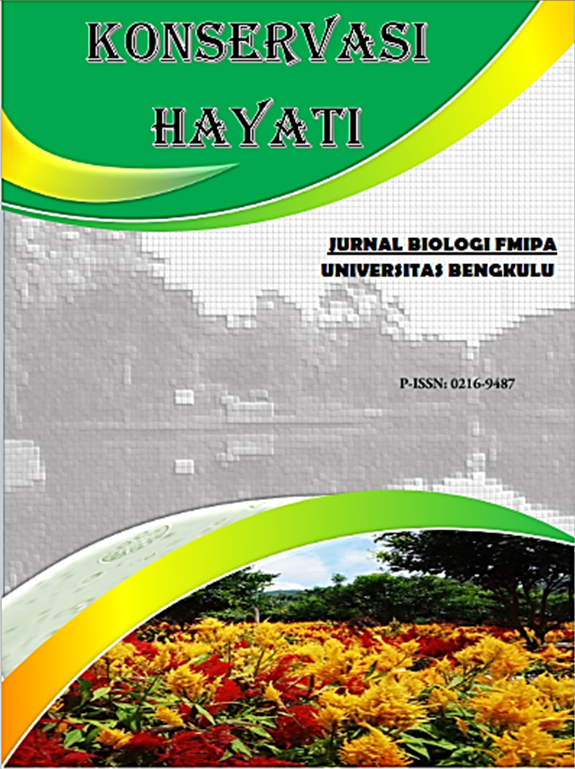Main Article Content
Abstract
Mosquitoes, one of the insects groups that have a high interaction with humans with a wide spread and cosmopolite. Factors that influence the spread of mosquitoes are the form of topography of an area and environmental factors. The aim of this research was to determine the type and abundance of mosquitoes (Diptera: Culicidae) in Banjarsari Village, Enggano District, North Bengkulu. The research was conducted in December 2018 to March 2019 with the sampling method of purposive sampling and capture of mosquitoes carried out by the Human Landing Collection and Resting Collection methods. The time of catching mosquitoes starts in the morning at 06.00-08.00 WIB, afternoon at 15.00-17.00 WIB and at night 18.00-24.00 WIB. The mosquito was identified in the Laboratory of Animal Physiology, Department of Biology, Faculty of Mathematics and Natural Sciences, Bengkulu University. The results of this research were analyzed in a qualitative frequency distribution with 3 groups of categories: many, medium and few categories. The types of mosquitoes obtained consisted of 5 types including Aedes albopictus, Armigeres subalbatus, Culex bitaeniorhynchus, Culex solitarius and Culex quinquefasciatus. The abundance of mosquitoes with many categories is found in Aedes albopictus and the abundance of categories with few species is found in Culex solitarius mosquitoes.
Keywords
Article Details
Authors who publish in this journal agree with the following terms:
- Authors retain copyright and grant the journal right of first publication with the work simultaneously licensed under a Creative Commons Attribution-ShareAlike 4.0 International License that allows others to share the work with an acknowledgement of the work's authorship and initial publication in this journal.
- Authors are able to enter into separate, additional contractual arrangements for the non-exclusive distribution of the journal's published version of the work (e.g., post it to an institutional repository or publish it in a book), with an acknowledgement of its initial publication in this journal.
- Authors are permitted and encouraged to post their work online (e.g., in institutional repositories or on their website) prior to and during the submission process, as it can lead to productive exchanges, as well as earlier and greater citation of published work (See The Effect of Open Access).
- This work is licensed under a Creative Commons Attribution-ShareAlike 4.0 International License.
References
- Astuti, E.P. dan Marina,R. 2009. Oviposisi dan Perkembangan Nyamuk Armigeres Pada Berbagai Bahan Kontainer. Jurnal Loka Litbang P2B2 Ciamis, 1(2): 87– 93.
- Boesri, H. 2011. Biologi dan Peranan Aedes albopictus sebagai Penular Penyakit. Jurnal Balai Penelitian dan Pengebangan Vektor dan Reservoir Salatiga, Badan Litbang, 3(2): 117–125.
- Direktorat Pengendalian Penyakit Bersumber Binatang. 2014. Pedoman Manajemen Malaria. Jakarta Pusat: Direktorat PP dan PL Press.
- Departemen Kesehatan. 1999. Ekologi Vektor dan Beberapa Aspek Perilaku.Dit.jen.PPM&PLP. Jakarta.
- Guillaumot,L. 2005. Arbovirus and their vectors in the Pacific status report. Pacific Health Surveillance and Response 12:45–52.
- Hadi, U.K., Koesharto F.X. 2006. Nyamuk. (Dalam) Sigit, S.H dan Hadi, U.K. Hal. 23 -51.
- Juhairiyah, Ridha M.R., Fakhrizal D. 2018. Pengaruh Iklim Terhadap Peluang Umur Nyamuk Mansonia spp di Daerah Endemis Filariasis di Kabupaten Kapuas. Jurnal Kesehatan Lingkungan Indonesia. 17 (2): 74 - 79.
- Lestari, B.D., Z.P. Gama., dan B. Rahardi. 2010. Identifikasi nyamuk di Kelurahan Sawojajar Kota Malang. Malang: Fakultas Matematika dan Ilmu Pengetahuan Alam. Universitas Brawijaya.
- New Zealand Biosecure Entomology Laboratory. 2007. Aedes albopictus. (skuse)
References
Astuti, E.P. dan Marina,R. 2009. Oviposisi dan Perkembangan Nyamuk Armigeres Pada Berbagai Bahan Kontainer. Jurnal Loka Litbang P2B2 Ciamis, 1(2): 87– 93.
Boesri, H. 2011. Biologi dan Peranan Aedes albopictus sebagai Penular Penyakit. Jurnal Balai Penelitian dan Pengebangan Vektor dan Reservoir Salatiga, Badan Litbang, 3(2): 117–125.
Direktorat Pengendalian Penyakit Bersumber Binatang. 2014. Pedoman Manajemen Malaria. Jakarta Pusat: Direktorat PP dan PL Press.
Departemen Kesehatan. 1999. Ekologi Vektor dan Beberapa Aspek Perilaku.Dit.jen.PPM&PLP. Jakarta.
Guillaumot,L. 2005. Arbovirus and their vectors in the Pacific status report. Pacific Health Surveillance and Response 12:45–52.
Hadi, U.K., Koesharto F.X. 2006. Nyamuk. (Dalam) Sigit, S.H dan Hadi, U.K. Hal. 23 -51.
Juhairiyah, Ridha M.R., Fakhrizal D. 2018. Pengaruh Iklim Terhadap Peluang Umur Nyamuk Mansonia spp di Daerah Endemis Filariasis di Kabupaten Kapuas. Jurnal Kesehatan Lingkungan Indonesia. 17 (2): 74 - 79.
Lestari, B.D., Z.P. Gama., dan B. Rahardi. 2010. Identifikasi nyamuk di Kelurahan Sawojajar Kota Malang. Malang: Fakultas Matematika dan Ilmu Pengetahuan Alam. Universitas Brawijaya.
New Zealand Biosecure Entomology Laboratory. 2007. Aedes albopictus. (skuse)
